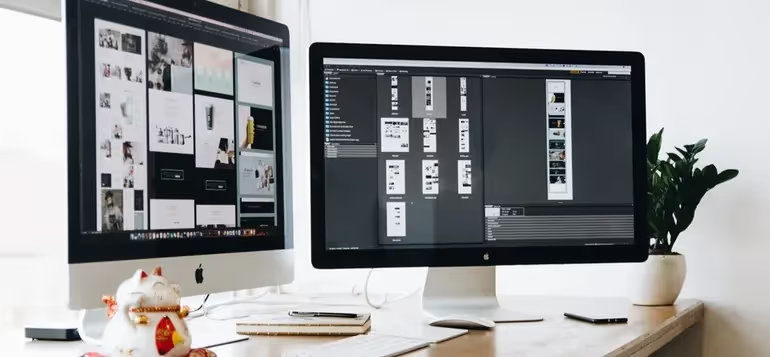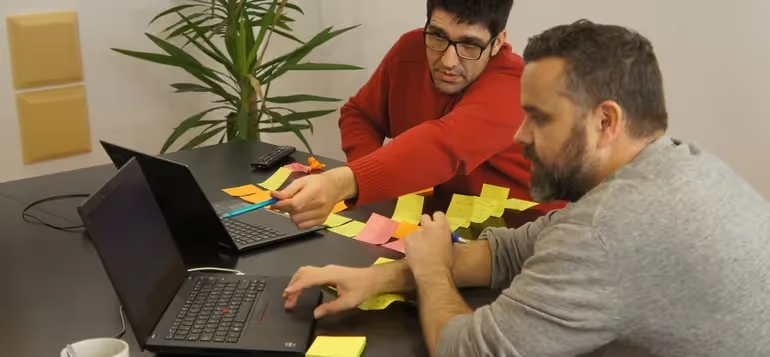8 Tips for a User-Friendly Website

In this article, we'll look at what affects usability and how we can optimize it.
The goal is for you, who are dealing with a digital solution, to think like a usability expert. Enjoy your reading!
What is good usability?
Una good user experience basically it's based on the fact that the web solution is user-friendly. But first let's determine what good usability is.
Ser user-friendly means making the path easy for the user. The user must be able to navigate and find information without getting frustrated or lost. When a solution is clear and intuitive to use, it's user-friendly.
Therefore, the next question is...
How to create a clear and intuitive solution?

Start with navigation
One of the most important things is to make it easy for the user to move around the web. Try — to test your page — to show a user a random subpage of your website so that they respond to the following:
- What is this?
- Where am I?
- What can I do here?
The questions should preferably be easy for the user to answer, without taking much time to answer.
Creates calm and an overview
For the user to easily get an overview of your website, it's important that they can decipher what they see on the screen. You can make the web easily decryptable as follows:
- Create a visual hierarchy of the different elements of the page — the most important elements that are the backbone of the page's content should attract the most attention.
- Usa fixed design elements on all pages, so that the user knows what each element means.
- I know consisting of the location and functions of the elements, so that the user doesn't have to search for specific elements or get confused because they don't all behave the same way.
- Divide pages into sections clearly defined and, therefore, creates a flow and a priority in reading the user.
- Make it clear what's clickable and what's not, using Call To Action buttons and highlighting on the page the elements that are clickable.
- Avoid noise limiting the amount of information and elements that are merely decorative padding.
Limit, limit, limit
When a user lands on a website, the user doesn't read. No; just scan the page.
Users have busy lives and want to find what they're looking for. So, when you're writing web text, remember:
- Cut the amount of text by half.
- Then cut that amount back in half — and you'd have it!
8 golden rules for good usability

1- It's never obvious enough
When a user opens an app or a website, they should be able to understand what the purpose of the page is. And it should be as obvious as possible.
2- Don't make me think, thank you!
If a web solution makes the user have to go around the page, or think, then it's not user-friendly enough. It shouldn't be a challenge for users to understand how to use a web solution. All they want is to understand what the next step is. The more you make the user think about your solution, the more likely it is that the user will find another page that makes things easier for them.
3- Remember to include a back button
It may not be the most important button in the world, but it is one of the most used elements on the Internet today: the back button. The user loses a little fear of making a mistake if there is a back button. Therefore, it helps the user to take a step back, especially in a purchase flow.
4- Show the way to “home”
The “home” button is the last emergency exit for users who get lost and whose back button hasn't helped them. Make it visible how to return to the home.
5- Remember that we are animals of habit
If a web solution works very well, the user will come back again and again. It's vitally important that your web solution is ultra-refined and that the user knows how to use it - even if there is another service with more products, lower prices or better content.
6- There are people who love searching — give them the opportunity to do so
There is a certain group of users who have become dependent on the search. For them, finding what they are looking for is a must. Therefore, give them the opportunity to search for information using a visible search function.
7- If you change the structure, you also change the behavior
Users remember their experience interacting with a website or app. They learn where to find what they want and how to do it. You risk destroying the ability to remember these steps and confusing your returning users if you change the structure of your web solution and, therefore, the habits of the users. Remember, it's important to think about the consequences of the changes you make.
8- In short: Avoid wasting time
In short, you must be careful not to waste the time of users making it difficult for them to visit your website. Keep in mind that generally we search the Internet for a specific reason and, above all, to save time. If you don't communicate in a clear way, then the user will look elsewhere. It also has a negative impact on Google search results, since load time and bounce rate — that is, the percentage of users who enter your website and leave it immediately — affect how Google positions you.
Therefore: Make sure you get to the point. Fast.

Involve the protagonists
Are you thinking of testing the usability of your website?
Then start with the users. As a worker, you have different reasons for visiting your website than your users, so you are biased for this purpose. There are many online services where you can test your website, including seeing how users use your solution and being able to understand how they move around your website. There can be a big difference between what users say and actually do.
“Think Out Loud” Protocol
One of the most commonly used methods for engaging users is the “think out loud” protocol. Here, a group (usually of 5-6 users) is asked to try to perform a series of tasks, which they should be able to perform on the website, while being instructed. This exercise provides a nuanced picture of the user experience on the web, while obtaining insights on:
- What is the immediate perception of the solution
- Which functionalities cause the greatest difficulties and which can be used without problems
- The interpretation that is made of icons, menu items and other important elements
- Where users expect to find the search in the web solution
Novicell has extensive experience combining inputs from: 1) usability experts, 2) key people in the internal functioning of a company and 3) the users themselves — to nail down an experience user-friendly.
If you want Go deeper into the user experience, we invite you to the seminar that we will hold on July 23 in the morning at our office in Barcelona. In this seminar, we will focus on the importance of personalizing the user experience to improve engagement and conversion. We will talk about some tools that will help us customize our website, e-mailing campaigns, etc.

How can we help you?
If you need more information, do not hesitate to contact us.
Cómo podemos ayudarte
Consulta los servicios con los que te ayudaremos a conseguir tus objetivos digitales.